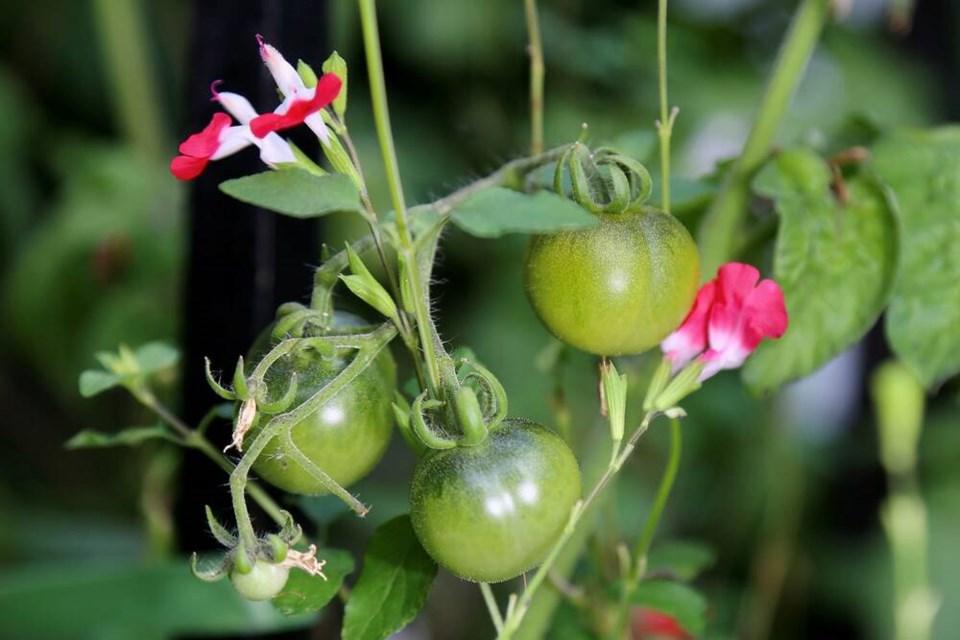In our family, “tomato rain” is a seasonal phenomenon that occurs in September, while canning tomatoes outside in torrential rain, cold winds, and inevitable power-outages. Tomato rain typically happens when children return to school. But not so this year.
One can’t know for certain whether our sodden August was due to a changing climate, or just one of those things that dampens our spirits, but most certainly the tomatoes did not love it.
After an OK start in May and June, tomatoes with and without rain cover were decently blossomed, though many people reported lower than average fruit set.
As tomatoes are self-pollinating, this may have had less to do with dwindling pollinator populations buzzing around and vibrating pollen hither and yon, and more to do with sticky pollen that simply could not let go. Both high heat and humidity over extended periods of time could be to blame.
Without a doubt, extended periods of damp caused tomato leaf mould: those tiny grey dots that appear suddenly on tomato leaves, and can spread like wildfire. I heard from clients and friends alike, that the dreaded mould had set in.
I am not a fan of foliar spraying tomatoes with goodness like compost tea, unless there is sufficient air circulation and heat build-up during the day to dry off the damp.
Soil level watering with sea mineral and kelp-enriched tea can fortify the plant and significantly improve its defense systems. In my experience, the best one can do is remove the worst of the damaged leaves, and encourage healing with added nutrients.
Interestingly, the Sweet Baby Jade dwarf tomato plants – that we grew from seed and transplanted into a part-sun polyculture “hummingbird” planter on the patio – remained blemish-free and outperformed each of the other 20 tomato types we grew elsewhere in dedicated, mixed-variety beds.
Sweet Baby Jade was created by independent Canadian tomato breeder Karen Olivier, a.k.a. Northern Gardener. Gorgeous varietals with homegrown names like Midnight Sun, Polaris, Taiga, Oyster Bay and Chinook populate her colourful Facebook page. I purchased Sweet Baby Jade seeds in the charming online shop of Sow Local Seeds in Nova Scotia.
My “N-of-one” trial of these diminutive tomatoes implies that they are hardy and resilient, but also that growing in community (polyculture) as plants do in nature is beneficial both above and below soil level. We know this to be true generally. Also, I believe that the ever-present hummingbirds and other pollinators who frequent the planter from dawn through dusk generate sufficient ongoing air circulation to improve fruit-set and prevent the descent of mildew.
I cannot know any of this for sure, but I will without question repeat the planting again. For the previous two summers, we trialed several varieties of currant tomatoes in the mixed hummingbird planters. And while fruit set was five-fold that of currants in dedicated tomato planters, the indeterminate vines were unwieldy and required excessive staking. Over time, the alfresco dining table-side arrangement became distractingly messy.
Sweet Baby Jade, however, is performing beautifully still, promising several more delicious and maintenance-free weeks. The three plants required minimal staking, and unlike bush-type tomatoes, grew thick and sturdy stalks well suited to containers.
The small-to-large, cherry-type fruit are imperceptible initially among the foliage, and then ripen to a deep jade green speckled with chartreuse, rather like shiny round okra.
On the plate they are magnificent to look at and to eat. My husband commented yesterday: “These are the sweetest tomatoes I have ever eaten.”
Laura Marie Neubert is a West Vancouver-based urban permaculture designer. Follow her on Instagram @upfrontandbeautiful, learn more about permaculture by visiting her Upfront & Beautiful website or email your questions to her here.
For a taste of permaculture, watch the video below:




